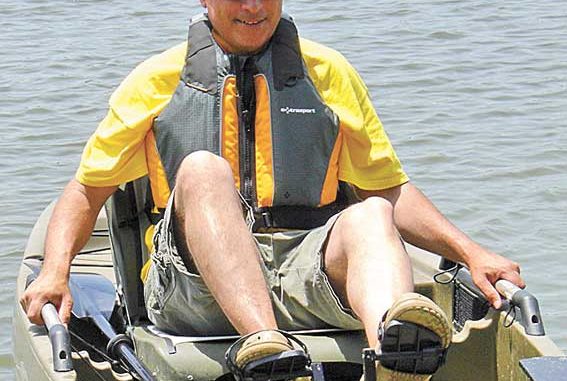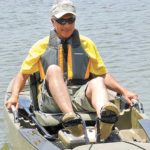
The Baton Rouge area offers plenty of public ponds that present anglers young and old the opportunity to fill their stringers.
Cormier’s First Law of Paddling states that choosing a paddlecraft is an exercise in compromise. Some kayak buyers are avoiding their exercise. They’re becoming “couch potatoes” when it comes to choosing the proper boat for their angling needs.
And why not? There’s less to compromise on these days.
One sacrifice that kayak anglers don’t like is giving up speed for stability. For example, a wide boat is more stable, and it allows more room for gear, but it’s also slower than a narrow boat.
One possibility is to get a longer boat. Longer boats are faster. But again that dasterdly law of mine comes into play. Longer boats are less manuverable, weigh more and with greater side surface area, are more prone to crosswind.
In their quest to come up with the perfect fishing kayak, manufacturers are trying every angle possible to beat a few of the laws of physics, or at least skirt around them.
One way to get more speed is to pedal a boat rather than paddle it. Paddling is inefficient because half of each stroke is lost to the air. In addition, legs have greater strength and endurance than arms do.
In 1998, Hobie Cat devised a pedal-based propulsion system for use in sit-on-top kayaks. Their patented Mirage Drive uses the oscillating foil principle that penguins and tuna use to propel themselves.
As your feet stroke the pedals back and forth, two long blades sweep from side to side underneath the kayak. As opposed to the rotating blades of a trolling motor or other propellor system, the Mirage Drive is able to move a lot of water with very little turbulence, enabling the paddler — or in this case, pedaler — to reach optimum hull speed with less effort.
The unit is lightweight, and can be pulled in or out rather easily. The Hobie yaks have a built-in housing that locks the drive in place for use.
The Mirage Drive has made Hobie Kayaks one of the best-selling boats on the northern Gulf Coast. They are extremely popular in the Florida Panhandle area, where yak anglers, working the beaches, like their hands free to constantly cast to fast-moving schools of Spanish, bonito, kings and even tarpon.
Mike Mathews is owner of The Backpacker, one of the largest kayak dealers in the South. He’s seen a shift in sales in the last year, from more conventional boats to the Hobies.
“The big misconception about the Hobie boats was that you can’t use them in shallow water,” he said. “The blades do extend over a foot, but by pushing the pedals forward, the blades lock back up against the hull. At worst, you lose only a couple of inches of draft.”.
As Hobie sales moved up, others decided it was time to join the game.
When Native Watercraft first hit the market in 2006, they blurred the line between canoe and kayak with their Ultimate 12 model. The tunnel hull, the raised seating and large storage capacity suggested canoe, but the low profile and narrow width suggested kayak.
For 2009, Native has added the Propel Pedal Drive System to their line. Constructed of marine-grade anodized aluminum and completely sealed against sand and mud, the “lower unit” looks and operates just like a standard trolling motor.
Unlike the Hobie, the Native system is more bicycle in nature. Each turn of the pedal generates 10 revolutions of the prop. For operation in shallow water, the Propel uses a pivoting rod that allows for raising or lowering.
Dick Williams operates Pack and Paddle in Lafayette, one of the largest Native dealers in the state. During a recent demo at Lake Martin, he told me the Propel system has many freshwater anglers excited.
“Bass fishermen want to be able to cast while moving,” he said. “And besides, waving a paddle can sometimes spook the bass.”
And there’s more good news: As long as the propulsion is human-powered, a boat is legal for use in kayak fishing tournaments, such as this summer’s CCA-Louisiana STAR Kayak Division.
With so few compromises, is Cormier’s First Law in jeopardy?
No, not when you consider there’s a new compromise that has to be made: price. These pedal boats run from $1,600 to $2,400 depending on the setup and accessories. Compare that to the standard kayak price of $600 to $900.
OK, but are they fast enough to be worth the extra bucks?
My standard procedure for measuring speed is to setup two PVC posts about a hundred yards apart and paddle — or in some cases, pedal — a boat from one post to the other.
The fastest fishing kayak I’ve ever paddled is a Pungo 140. It’s a 14-foot long, sit-inside kayak, otherwise termed as SINKs, as opposed to the more popular sit-on-tops, a.k.a. SOTs. No SOT has ever beat a SINK for the same length in any of my tests.
Among the more popular fishing kayaks, the Hobie Revolution with the Mirage Drive is the fastest SOT I’ve ever tested. In fact, all of the Hobie models with the Mirage drive were faster than their paddle-based competition — but not by much. The Outback tested only 3 seconds faster than the Ocean Kayak Prowler 13 and the Wilderness Systems Tarpon 140.
Oddly, my own Ocean Kayak Caper, an 11-foot boat, was only 5 seconds slower than the Outback. I didn’t buy this boat for its speed, but for its terrific manuverability (I fish a lot in fresh water) and stability.
The new Hobie Pro Angler is perhaps the most stable boat ever offered. It’s a whopping 38 inches wide — wider than some canoes. Despite its barge-like attributes, the boat (I refuse to call it a kayak) was faster with pedal power than most low-end paddle boats I tested.
I didn’t measure the speed on the Native with the Propel system, but my impression was that it too is faster than the Prowler or Tarpon.
It didn’t surprise me that some results were close. Another law — that of displacement hull speed — means that once a canoe or kayak reaches optimum speed for its length and width, that much more power is needed for each incremental increase in speed.
But the beauty of these foot-powered boats is that, once you reach the optimum cruising speed for that hull, you can propel the boat with less effort and over a much longer distance — and have the hands-free operation you desire.
In the end, it only makes sense to try before you buy. Perhaps like me, you still prefer the paddle over the pedal. At least now you have options.




